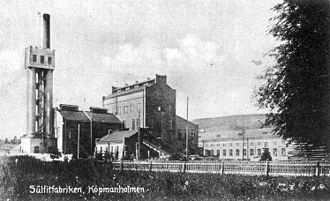Sulfite process

The sulphite process is a chemical-industrial process developed in the 19th century for the extraction of cellulose from wood. It is only suitable for woods that are low in resin and low silica.
Procedure
| Procedure | pH values | Cations |
|---|---|---|
| angry | 1.2-1.8 | Ca 2+ , (Mg 2+ , Na + , NH 4 + ) |
| bisulfite | 3.5-5.5 | Mg 2+ , (Na + , NH 4 + ) |
| neutral | 5-7 | Na + , NH 4 + |
With the sulfite process, depending on the cation used (calcium, magnesium, sodium, ammonium), the wood can be digested in an acidic or neutral environment ( wood digestion ). In the process, the lignin is subjected to a sulfonation with molecular reduction and is converted into a water-soluble salt of lignin sulfonic acid , which can easily be removed from the fiber. Depending on the pH value, the hemicelluloses in the wood are either converted into sugars (such as D-mannose , D-glucose , D-xylose , L-arabinose , D-galactose , L-rhamnose ) by acid hydrolysis and then go into the aqueous phase over, or they remain with the cellulose in the fiber. The very light-colored pulps produced in this way are now used almost exclusively for the production of chemical cellulose or paper . The lignosulfonates formed as a by-product are either used commercially or incinerated (recovery).
Around five solid cubic meters of wood and 90 kilograms of sulfur are required to produce 1,000 kilograms of pulp .
Calcium bisulfite process
The debarked wood , mechanically chopped into wood chips , is heated in pressure cookers with calcium hydrogen sulfite for seven to 15 hours at increased pressure (five to seven bar ). The pieces of wood become soft when cooked so that they can be crushed without much effort. They are then cut into two to four millimeters long fibers, washed several times and, if necessary, bleached before they are dried in the form of thick cardboard. Calcium bisulfite used to be extracted using an acid tower. Limestone was poured into the tube at the top and water was sprinkled over it, while sulfur dioxide was added at the bottom.
Pulps that are manufactured using the calcium bisulfite process are particularly pure and are therefore preferred for chemical applications. Since the calcium bisulphite process, in contrast to the other processes, cannot recycle the base , it is not very economical if the lignosulphonate is not recycled. Today it is only rarely used for the production of sulphite pulp.
Magnesium bisulfite process
The magnesium bisulfite process works similarly to that of calcium, but it can be used continuously. The base can be easily broken down into magnesium oxide and sulfur dioxide and therefore offers good chemical recovery. Accordingly, the resulting magnesium lignosulfonates are primarily incinerated (energy generation plus chemical recycling). They are only used for other purposes if there is insufficient incineration capacity. Often, however, a small part of the raw liquor is discharged in order to limit the accumulation of impurities that come from the wood (e.g. heavy metal ions) in the process.
Side processes
The wastewater with its high wood sugar content is often used to produce ethanol (lye brandy or sulphite fuel ). This is particularly possible when opening up coniferous wood. Nowadays, productions for the processing and recycling of lignosulfonate are often connected.
history
The sulfite process was invented in 1866 by the American Benjamin Tilghman (US patent 1867). In 1874 there was a legal dispute because Alexander Mitscherlich claimed to have invented this process as early as 1874 and to have placed it on an industrially usable framework. However, the Reichsgericht did not support this claim in 1884. In 1879 the first factory using the Mitscherlich method was built in Löhnbergerhütte ; Almost at the same time, the inventor himself and his brother built a factory in Hannoversch Münden . A factory in Sweden that was established in 1874 was based on the use of magnesium sulfite lye, as described by Carl Daniel Ekman . Another pioneer was Karl Kellner . In papermaking, the sulfate process has become a more competitive pulping process. Around 15 percent of the pulp used in Germany is obtained using the sulphite process; in 2008 this was 723,000 tons of sulphite pulp.
relevance
Chemical pulp, from which viscose and cellulose derivatives such as cellulose ethers and esters are made, is mainly made from spruce wood using this process . The importance of this process is essentially due to the very efficient delignification, the good bleachability, the high reactivity during further processing (with the same degree of purity ) and low investment costs. Sulphite pulps can be produced in a high degree of purity if the process steps are then carried out in the basic range (hot and cold alkali refinement).
literature
- Entry to cellulose. In: Römpp Online . Georg Thieme Verlag, accessed on June 20, 2014.
Individual evidence
- ↑ Klaus Beneke: Benjamin Chew Tilghman and on the history of paper and its raw materials, University of Kiel, pdf
- ↑ Verband deutscher Papierfabriken eV: Papierkompass 2009 ( page no longer available , search in web archives: pdf ( page no longer available , search in web archives ) Info: The link was automatically marked as defective. Please check the link according to the instructions and then remove this notice . ).
